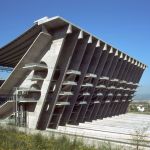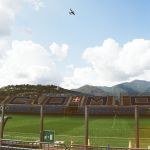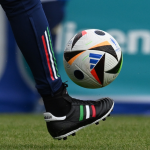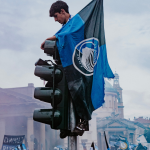Taking a walk in Piazza Duomo in Milan and moving towards Piazza Diaz it is difficult not to see the antennas and the green roof of the Velasca Tower, the first skyscraper that arose in Milan, in 1954. That skyscraper is one of the greatest examples of Brutalism, an architectural movement born in the 1940s in certain territories of Eastern Europe and then developed until the seventies all over the world, with important examples also in South America and Italy.
The stadiums, as monumental creatures and locus perfect for this type of architecture, have re-enter Brutalism with very spectacular examples, but over the years they have been lost. In fact, especially in South America, many plants built during the 1940s, 1950s and 1960s were modernized with new technologies and their iconic cement was covered (or replaced) by more sustainable and modern materials, redesigning the stadium figure according to postmodern principles and scanning its veins of pipes, bricks and lime. But there are still many examples, and these are the top ten.
Estádio Municipal de Braga
Location: Braga, Portogallo
Year of inauguration: 2002
Architect: Edoardo Souto de Moura
The Municipality of Braga is perhaps the
wired example of those in this ranking. It is in fact not only the most modern and young - built in the twenty-first century - but it also has a bizarre, atypical shape for any football facility. In fact, the field is covered only for two sides by the stands, which rise very high only along the vertical sides of the field. The other two sides are respectively the side of a
mountain and a park. The accordion structure of the stands is exposed naked outwards, letting you see the entire cement skeleton of the stadium with the rows of steps and load-bearing columns. The
Financial Times ranked it among the four most beautiful gaming facilities.
Hrazdan Stadium
Location: Erevan, Armenia
Year of inauguration: 1970
Architect: Edward Tossunia, Koryun Hakobyan, Gurgen Musheghyan
Like many buildings in Eastern Europe, the Stadium of Erevan was built following the principles of Brutalist architecture, which in those territories - from the Black Sea basin to the Balkans - were an aesthetic mantra in construction. It was Anastas Mikoyan, director of the Soviet Council of Ministers, who decided to have a stadium built in Erevan, taking advantage of the concaveness of the valley in which it still stands. Despite work on upgrades for car seats, press stands and lighting, the stadium has maintained its ring structure, and especially its concrete features, also visible from the adjacent street.
Estadio Monumental de Lima
Location: Lima, Perù
Year of inauguration: 2000
Architect: Walter Lavalleja
The Monumental of Lima, also known for its
"U-shape stadium" shape, is the largest stadium in South America. Its sectors are divided into two layers: one low with car seats, one high with booths and rooms to watch the game. From the outside, the Monumental looks like a long sequence of apartments, a bit of Ville Radieuse by Le Corbusier but with a South American touch. The stadium is considered one of the most
modern facilities in South America and spica for its impressive lighting headlights.
Stadio Giuseppe Meazza
Location: Milan, Italy
Anno di inaugurazione: 1925
Architect: Ulisse Stacchini
The San Siro Stadium has been renovated and expanded several times in its history, going from an initial capacity of 30,000 spectators in the 1930s to 65,000 in the 1960s and 80,000 today. The
sequence of rings fascinates the entire system and is, together with the towers on the sides to access the third ring, the characterizing element of the stadium. Its brutalist forms are exalted precisely in the
concrete rings visible from the outside, as if the Meazza offered its ribs to the vision of the spectators.
Skopje Arena (Tose Proeski)
Location: Skopje, Macedonia
Year of inauguration: 1947
Architect: Dragan Krstev, Todorka Mavkova
Named after Macedonian singer
Toše Proeski, Skopje's stadium was renovated in 2009 as part of a major sequence of state works to reorganize the image of Macedonia (independent of Greece) and its internationalization. A fundamental feature is the grandstand of honor, which like other stadiums built with structuralist concepts stands on a surge of columns and steps. Initially, in addition to the grandstand, there was only a small ring around the stadium, while now two rings have been built that come back to the central stands. In addition, the
skyline of the stands has a wave shape, which follows the large suspension arches. In 2017, it also hosted the
European Super Cup final between Real Madrid and Manchester United and this led to a further improvement in the plant's services.
Mineirao
Location: Belo Horizonte, Brasile
Year of inauguration: 1965
Architect: E. Mendes Guimaraes, Caspar Garreto
This stadium was supposed to represent hope: it was instead a theatre of ruin.
Mineirazo, in fact, Germany's historic
7-1 at brazil at the 2014 World Cup, took place right in the Belo Horizonte stadium, in a facility specially built for the World Cup and now unused. Despite the modernization for the Brazilian World Cup, Mineirao still possesses its cold
brutalist traits, clearly visible in the entrance gates, only to have the interior renovated and modern.Even the football club Atletico Mineiro left
Giante de Pampulha, going to play at Estadio Indipendencia.
Phnom Phen Olympic Stadium
Location: Phnom Phen, Cambogia
Year of inauguration: 1964
Architect: Vann Molyvan
In 1964, the South East Asian Games were to be held in Cambodia, then replaced (due to local problems) with the GANEFO Games. But in Phnom Phen they built the Olympic center with all the facilities for sports, from football to swimming pools to dormitories for athletes, and to meet the needs of maximum functionality (and save costs), the government had an extremely skeletal football facility built. The canons of Brutalism are very well etched in the official grandstand of the Olympic Stadium, with entrances and edges that, if it were not for the pigmentation of fans and fans who pass by on a daily basis, could have been a normal Soviet sports center.
Estadio do Morumbi
Location: Sao Paulo, Brazil
Year of inauguration: 1960
Architect: Joao Vilanova Artigas
Sao Paulo sports house since 1960, whatever great concert has been done in the great Paulista city has come to Morumbi: Madonna, U2, Red Hot Chili Peppers, Iron Maiden. Sao Paulo needed a house after repeated movements between various fields in the area, and in the 1960s this plant was inaugurated (partially), not yet completed and definitively succeeded in 1970. The ring structure envelops the plant with a lot of concrete: to maintain the 140,000 people you needed a more than solid structure. It was precisely the elliptical structure and the outflow so comfortable that were used to take a large number of people out of the plant. The curvilinear structure of the stadium reflects, instead, the style of the Paulista school of the architect of the plant, Joao Vilanova Artigas.
Estadio Azteca
Location: Città del Messico, Messico
Year of inauguration: 1967
Architect: V. Orekhov
Azteca Stadium is one of the three fundamental stadiums in the history of football. For Italians (as well as an entire generation of football players) it is a sacred place, that of
Partita del Siglo, itaila's
4-3 over Germany in 1970. But it is also a perfect brutalist site, whose
arches of support are visible even from afar so impressive and tall. The stadium is one of the largest in the world and its monumentality is also accentuated by the Colosseum structure, strongly characterized by the brutalist traits.
Free State Stadium
Location: Bloemfontaine, Sud Africa
Year of inauguration: 1955
Architect: E. Mendes Guimaraes, Caspar Garreto
Used mainly for rugby and already known as the Toyota Stadium, the Bloemfontaine Free State was modernised a decade ago for the 2010 World Cup in
South Africa. The roodt architects' studio has maintained its original structure (built in 1955) by enhancing the concave space behind the stands, with concrete walkways -
elbow-to-elbow - used as runoff channels from the stands. In addition to the World Cup, football for the Free State Stadium also means
Bloemfontaine Celtics, the
soccer team of the South African city.




































































































